Best Intervention for Compassion Fatigue in Palliative Care Nurses
VerifiedAdded on 2023/04/11
|12
|2844
|273
AI Summary
This research proposal aims to find the best intervention to address compassion fatigue among nurses working in palliative care units. The study will explore strategies to protect the mental health and productivity of nurses from repeated exposure to patient suffering. The research will use a secondary research design and thematic analysis to analyze data obtained from research literature.
Contribute Materials
Your contribution can guide someone’s learning journey. Share your
documents today.
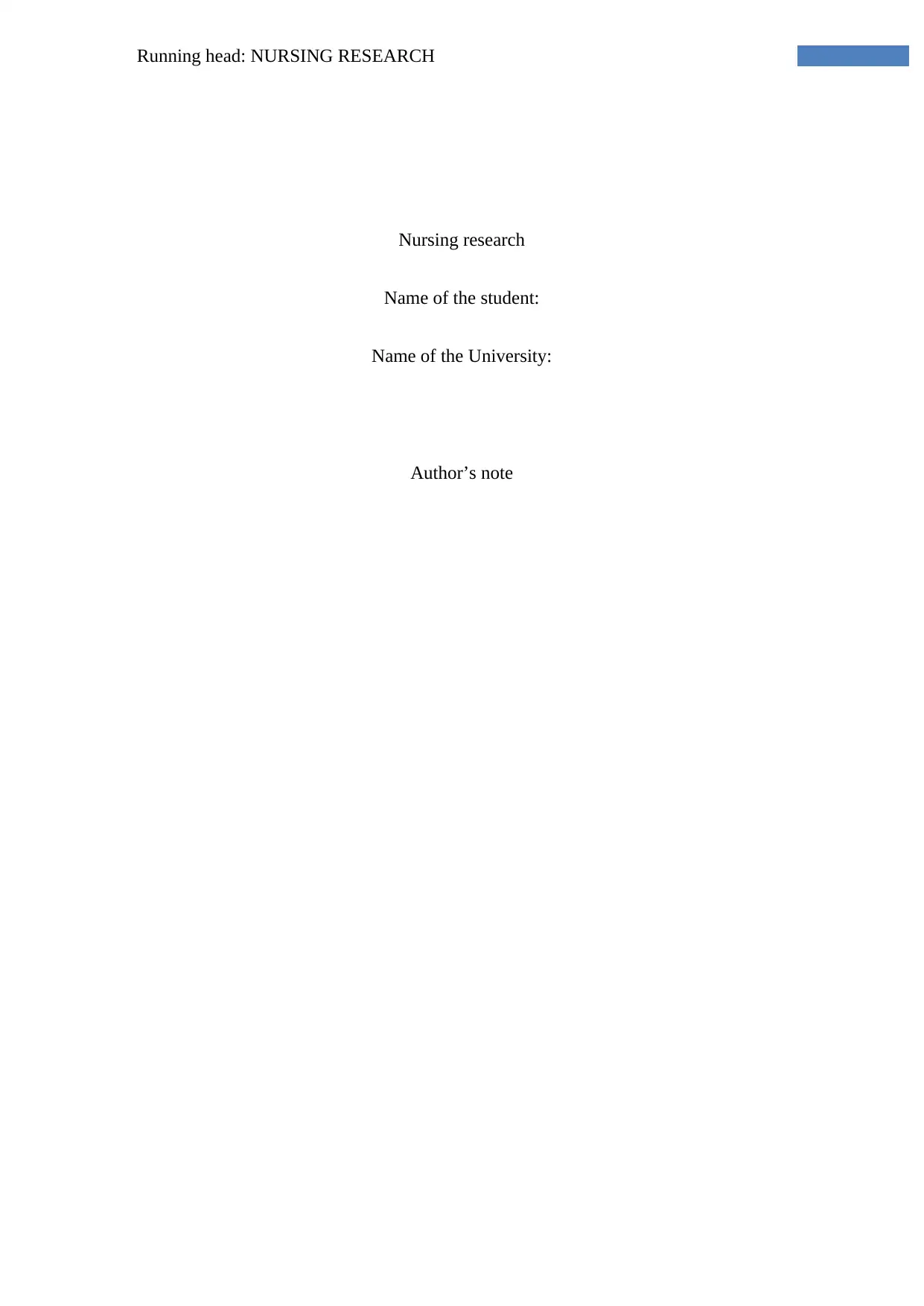
Running head: NURSING RESEARCH
Nursing research
Name of the student:
Name of the University:
Author’s note
Nursing research
Name of the student:
Name of the University:
Author’s note
Secure Best Marks with AI Grader
Need help grading? Try our AI Grader for instant feedback on your assignments.
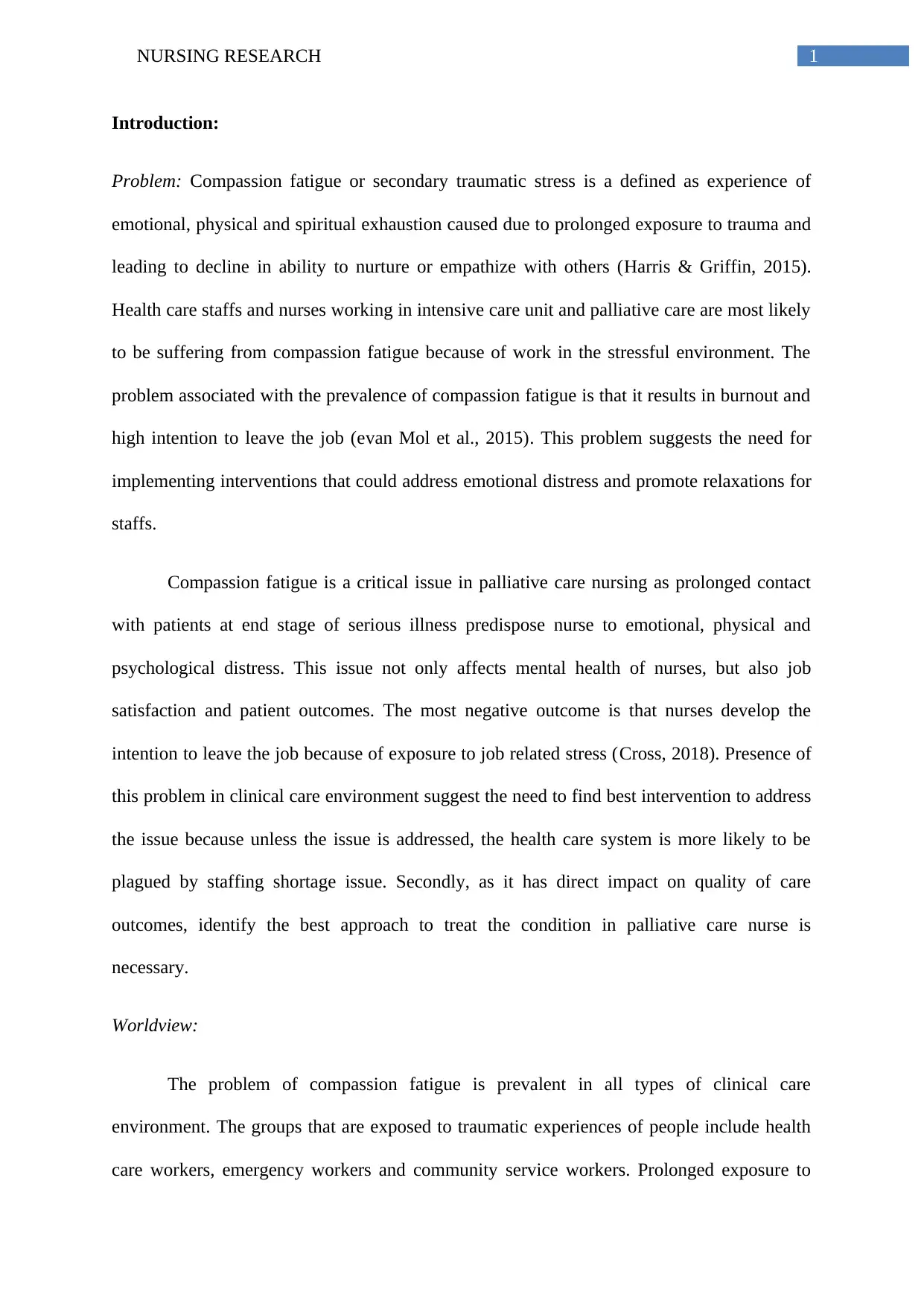
1NURSING RESEARCH
Introduction:
Problem: Compassion fatigue or secondary traumatic stress is a defined as experience of
emotional, physical and spiritual exhaustion caused due to prolonged exposure to trauma and
leading to decline in ability to nurture or empathize with others (Harris & Griffin, 2015).
Health care staffs and nurses working in intensive care unit and palliative care are most likely
to be suffering from compassion fatigue because of work in the stressful environment. The
problem associated with the prevalence of compassion fatigue is that it results in burnout and
high intention to leave the job (evan Mol et al., 2015). This problem suggests the need for
implementing interventions that could address emotional distress and promote relaxations for
staffs.
Compassion fatigue is a critical issue in palliative care nursing as prolonged contact
with patients at end stage of serious illness predispose nurse to emotional, physical and
psychological distress. This issue not only affects mental health of nurses, but also job
satisfaction and patient outcomes. The most negative outcome is that nurses develop the
intention to leave the job because of exposure to job related stress (Cross, 2018). Presence of
this problem in clinical care environment suggest the need to find best intervention to address
the issue because unless the issue is addressed, the health care system is more likely to be
plagued by staffing shortage issue. Secondly, as it has direct impact on quality of care
outcomes, identify the best approach to treat the condition in palliative care nurse is
necessary.
Worldview:
The problem of compassion fatigue is prevalent in all types of clinical care
environment. The groups that are exposed to traumatic experiences of people include health
care workers, emergency workers and community service workers. Prolonged exposure to
Introduction:
Problem: Compassion fatigue or secondary traumatic stress is a defined as experience of
emotional, physical and spiritual exhaustion caused due to prolonged exposure to trauma and
leading to decline in ability to nurture or empathize with others (Harris & Griffin, 2015).
Health care staffs and nurses working in intensive care unit and palliative care are most likely
to be suffering from compassion fatigue because of work in the stressful environment. The
problem associated with the prevalence of compassion fatigue is that it results in burnout and
high intention to leave the job (evan Mol et al., 2015). This problem suggests the need for
implementing interventions that could address emotional distress and promote relaxations for
staffs.
Compassion fatigue is a critical issue in palliative care nursing as prolonged contact
with patients at end stage of serious illness predispose nurse to emotional, physical and
psychological distress. This issue not only affects mental health of nurses, but also job
satisfaction and patient outcomes. The most negative outcome is that nurses develop the
intention to leave the job because of exposure to job related stress (Cross, 2018). Presence of
this problem in clinical care environment suggest the need to find best intervention to address
the issue because unless the issue is addressed, the health care system is more likely to be
plagued by staffing shortage issue. Secondly, as it has direct impact on quality of care
outcomes, identify the best approach to treat the condition in palliative care nurse is
necessary.
Worldview:
The problem of compassion fatigue is prevalent in all types of clinical care
environment. The groups that are exposed to traumatic experiences of people include health
care workers, emergency workers and community service workers. Prolonged exposure to
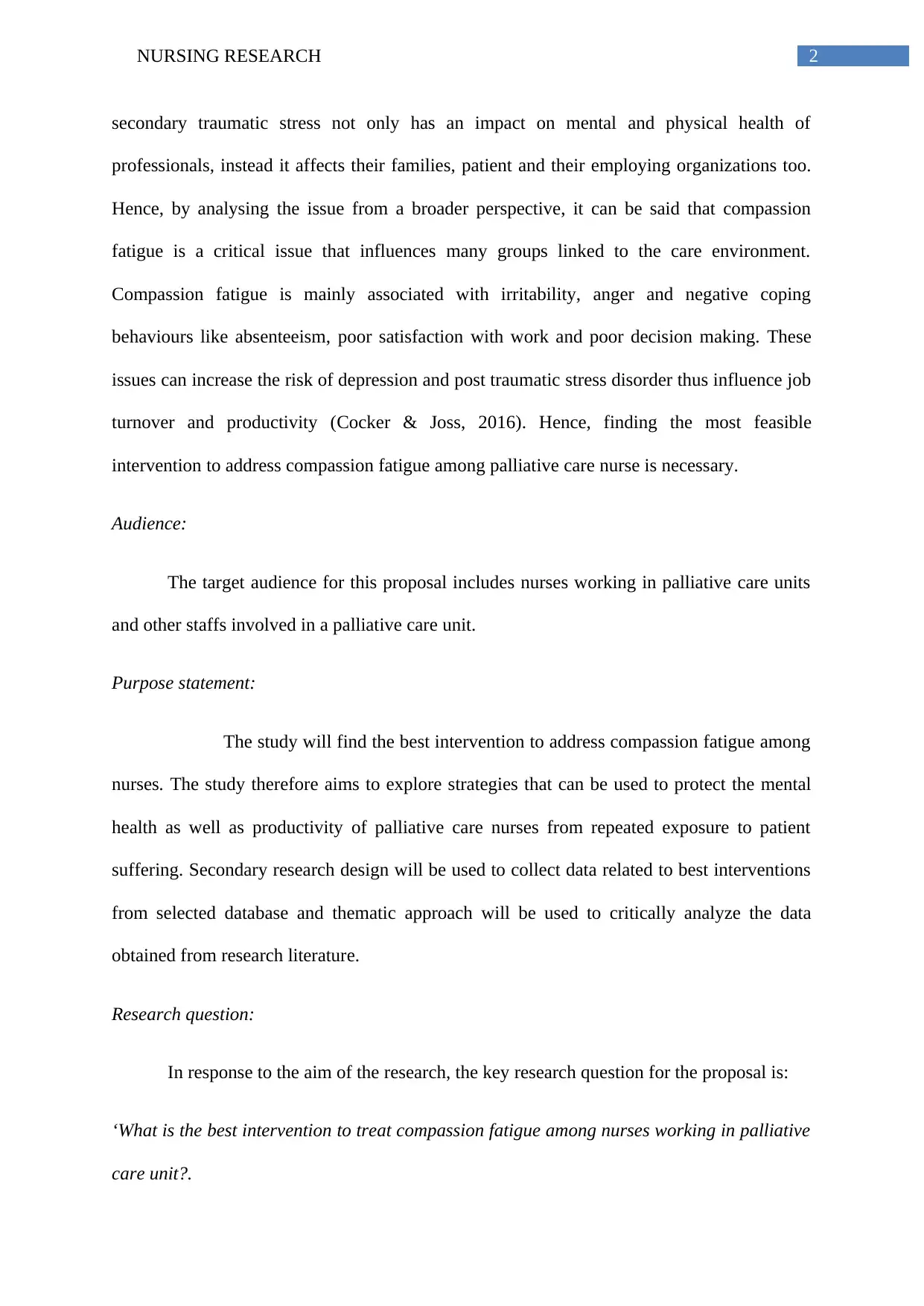
2NURSING RESEARCH
secondary traumatic stress not only has an impact on mental and physical health of
professionals, instead it affects their families, patient and their employing organizations too.
Hence, by analysing the issue from a broader perspective, it can be said that compassion
fatigue is a critical issue that influences many groups linked to the care environment.
Compassion fatigue is mainly associated with irritability, anger and negative coping
behaviours like absenteeism, poor satisfaction with work and poor decision making. These
issues can increase the risk of depression and post traumatic stress disorder thus influence job
turnover and productivity (Cocker & Joss, 2016). Hence, finding the most feasible
intervention to address compassion fatigue among palliative care nurse is necessary.
Audience:
The target audience for this proposal includes nurses working in palliative care units
and other staffs involved in a palliative care unit.
Purpose statement:
The study will find the best intervention to address compassion fatigue among
nurses. The study therefore aims to explore strategies that can be used to protect the mental
health as well as productivity of palliative care nurses from repeated exposure to patient
suffering. Secondary research design will be used to collect data related to best interventions
from selected database and thematic approach will be used to critically analyze the data
obtained from research literature.
Research question:
In response to the aim of the research, the key research question for the proposal is:
‘What is the best intervention to treat compassion fatigue among nurses working in palliative
care unit?.
secondary traumatic stress not only has an impact on mental and physical health of
professionals, instead it affects their families, patient and their employing organizations too.
Hence, by analysing the issue from a broader perspective, it can be said that compassion
fatigue is a critical issue that influences many groups linked to the care environment.
Compassion fatigue is mainly associated with irritability, anger and negative coping
behaviours like absenteeism, poor satisfaction with work and poor decision making. These
issues can increase the risk of depression and post traumatic stress disorder thus influence job
turnover and productivity (Cocker & Joss, 2016). Hence, finding the most feasible
intervention to address compassion fatigue among palliative care nurse is necessary.
Audience:
The target audience for this proposal includes nurses working in palliative care units
and other staffs involved in a palliative care unit.
Purpose statement:
The study will find the best intervention to address compassion fatigue among
nurses. The study therefore aims to explore strategies that can be used to protect the mental
health as well as productivity of palliative care nurses from repeated exposure to patient
suffering. Secondary research design will be used to collect data related to best interventions
from selected database and thematic approach will be used to critically analyze the data
obtained from research literature.
Research question:
In response to the aim of the research, the key research question for the proposal is:
‘What is the best intervention to treat compassion fatigue among nurses working in palliative
care unit?.
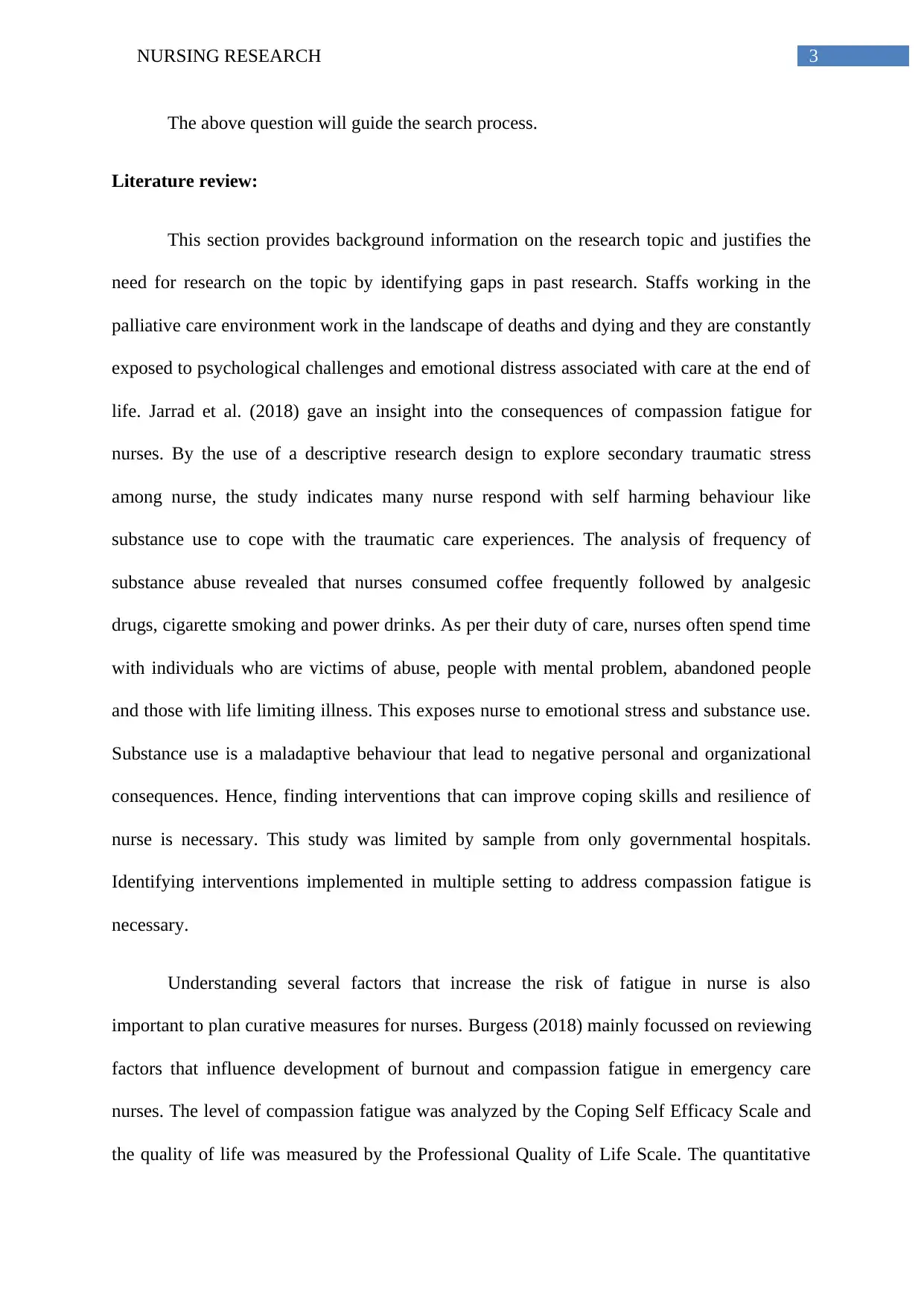
3NURSING RESEARCH
The above question will guide the search process.
Literature review:
This section provides background information on the research topic and justifies the
need for research on the topic by identifying gaps in past research. Staffs working in the
palliative care environment work in the landscape of deaths and dying and they are constantly
exposed to psychological challenges and emotional distress associated with care at the end of
life. Jarrad et al. (2018) gave an insight into the consequences of compassion fatigue for
nurses. By the use of a descriptive research design to explore secondary traumatic stress
among nurse, the study indicates many nurse respond with self harming behaviour like
substance use to cope with the traumatic care experiences. The analysis of frequency of
substance abuse revealed that nurses consumed coffee frequently followed by analgesic
drugs, cigarette smoking and power drinks. As per their duty of care, nurses often spend time
with individuals who are victims of abuse, people with mental problem, abandoned people
and those with life limiting illness. This exposes nurse to emotional stress and substance use.
Substance use is a maladaptive behaviour that lead to negative personal and organizational
consequences. Hence, finding interventions that can improve coping skills and resilience of
nurse is necessary. This study was limited by sample from only governmental hospitals.
Identifying interventions implemented in multiple setting to address compassion fatigue is
necessary.
Understanding several factors that increase the risk of fatigue in nurse is also
important to plan curative measures for nurses. Burgess (2018) mainly focussed on reviewing
factors that influence development of burnout and compassion fatigue in emergency care
nurses. The level of compassion fatigue was analyzed by the Coping Self Efficacy Scale and
the quality of life was measured by the Professional Quality of Life Scale. The quantitative
The above question will guide the search process.
Literature review:
This section provides background information on the research topic and justifies the
need for research on the topic by identifying gaps in past research. Staffs working in the
palliative care environment work in the landscape of deaths and dying and they are constantly
exposed to psychological challenges and emotional distress associated with care at the end of
life. Jarrad et al. (2018) gave an insight into the consequences of compassion fatigue for
nurses. By the use of a descriptive research design to explore secondary traumatic stress
among nurse, the study indicates many nurse respond with self harming behaviour like
substance use to cope with the traumatic care experiences. The analysis of frequency of
substance abuse revealed that nurses consumed coffee frequently followed by analgesic
drugs, cigarette smoking and power drinks. As per their duty of care, nurses often spend time
with individuals who are victims of abuse, people with mental problem, abandoned people
and those with life limiting illness. This exposes nurse to emotional stress and substance use.
Substance use is a maladaptive behaviour that lead to negative personal and organizational
consequences. Hence, finding interventions that can improve coping skills and resilience of
nurse is necessary. This study was limited by sample from only governmental hospitals.
Identifying interventions implemented in multiple setting to address compassion fatigue is
necessary.
Understanding several factors that increase the risk of fatigue in nurse is also
important to plan curative measures for nurses. Burgess (2018) mainly focussed on reviewing
factors that influence development of burnout and compassion fatigue in emergency care
nurses. The level of compassion fatigue was analyzed by the Coping Self Efficacy Scale and
the quality of life was measured by the Professional Quality of Life Scale. The quantitative
Secure Best Marks with AI Grader
Need help grading? Try our AI Grader for instant feedback on your assignments.
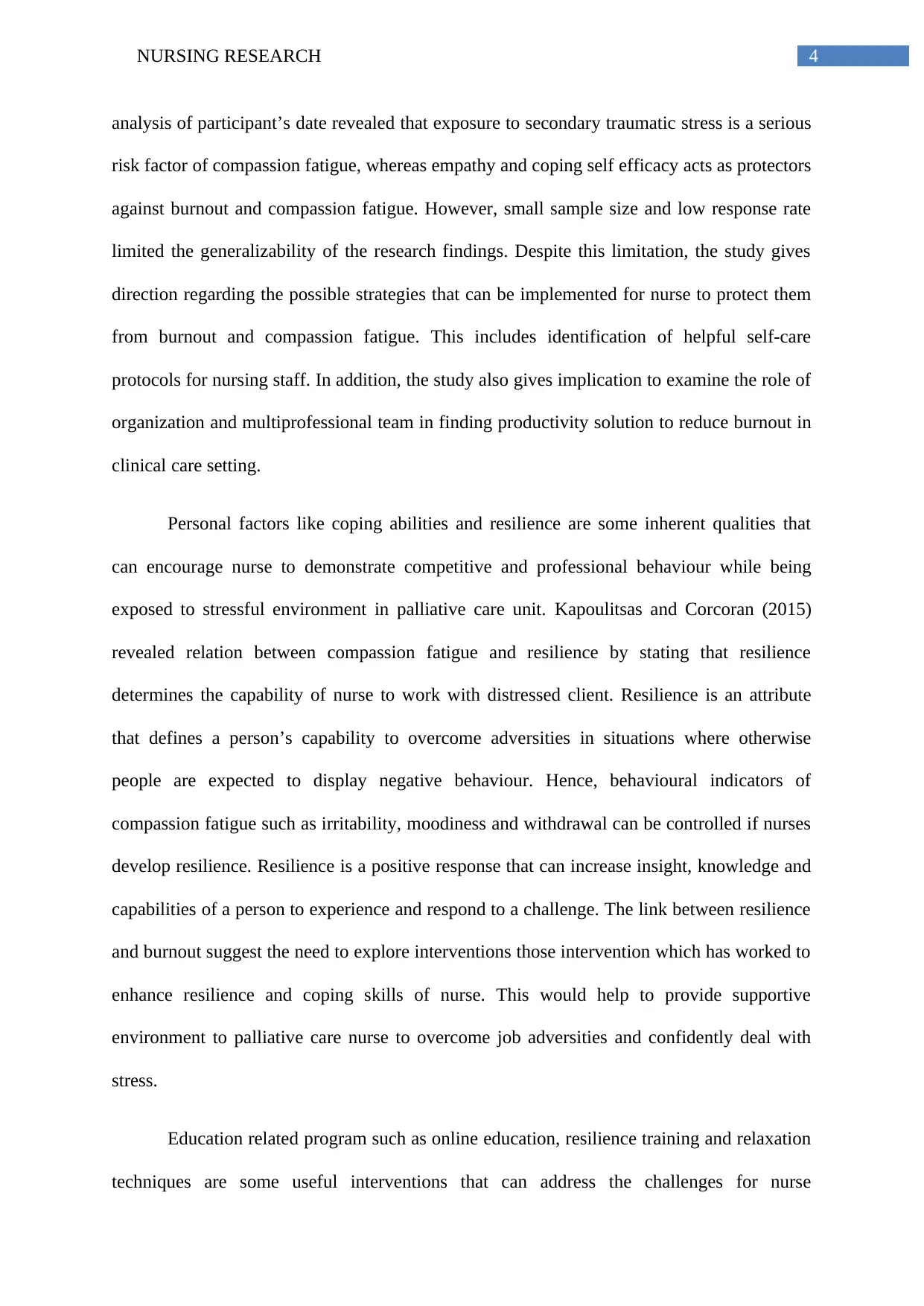
4NURSING RESEARCH
analysis of participant’s date revealed that exposure to secondary traumatic stress is a serious
risk factor of compassion fatigue, whereas empathy and coping self efficacy acts as protectors
against burnout and compassion fatigue. However, small sample size and low response rate
limited the generalizability of the research findings. Despite this limitation, the study gives
direction regarding the possible strategies that can be implemented for nurse to protect them
from burnout and compassion fatigue. This includes identification of helpful self-care
protocols for nursing staff. In addition, the study also gives implication to examine the role of
organization and multiprofessional team in finding productivity solution to reduce burnout in
clinical care setting.
Personal factors like coping abilities and resilience are some inherent qualities that
can encourage nurse to demonstrate competitive and professional behaviour while being
exposed to stressful environment in palliative care unit. Kapoulitsas and Corcoran (2015)
revealed relation between compassion fatigue and resilience by stating that resilience
determines the capability of nurse to work with distressed client. Resilience is an attribute
that defines a person’s capability to overcome adversities in situations where otherwise
people are expected to display negative behaviour. Hence, behavioural indicators of
compassion fatigue such as irritability, moodiness and withdrawal can be controlled if nurses
develop resilience. Resilience is a positive response that can increase insight, knowledge and
capabilities of a person to experience and respond to a challenge. The link between resilience
and burnout suggest the need to explore interventions those intervention which has worked to
enhance resilience and coping skills of nurse. This would help to provide supportive
environment to palliative care nurse to overcome job adversities and confidently deal with
stress.
Education related program such as online education, resilience training and relaxation
techniques are some useful interventions that can address the challenges for nurse
analysis of participant’s date revealed that exposure to secondary traumatic stress is a serious
risk factor of compassion fatigue, whereas empathy and coping self efficacy acts as protectors
against burnout and compassion fatigue. However, small sample size and low response rate
limited the generalizability of the research findings. Despite this limitation, the study gives
direction regarding the possible strategies that can be implemented for nurse to protect them
from burnout and compassion fatigue. This includes identification of helpful self-care
protocols for nursing staff. In addition, the study also gives implication to examine the role of
organization and multiprofessional team in finding productivity solution to reduce burnout in
clinical care setting.
Personal factors like coping abilities and resilience are some inherent qualities that
can encourage nurse to demonstrate competitive and professional behaviour while being
exposed to stressful environment in palliative care unit. Kapoulitsas and Corcoran (2015)
revealed relation between compassion fatigue and resilience by stating that resilience
determines the capability of nurse to work with distressed client. Resilience is an attribute
that defines a person’s capability to overcome adversities in situations where otherwise
people are expected to display negative behaviour. Hence, behavioural indicators of
compassion fatigue such as irritability, moodiness and withdrawal can be controlled if nurses
develop resilience. Resilience is a positive response that can increase insight, knowledge and
capabilities of a person to experience and respond to a challenge. The link between resilience
and burnout suggest the need to explore interventions those intervention which has worked to
enhance resilience and coping skills of nurse. This would help to provide supportive
environment to palliative care nurse to overcome job adversities and confidently deal with
stress.
Education related program such as online education, resilience training and relaxation
techniques are some useful interventions that can address the challenges for nurse
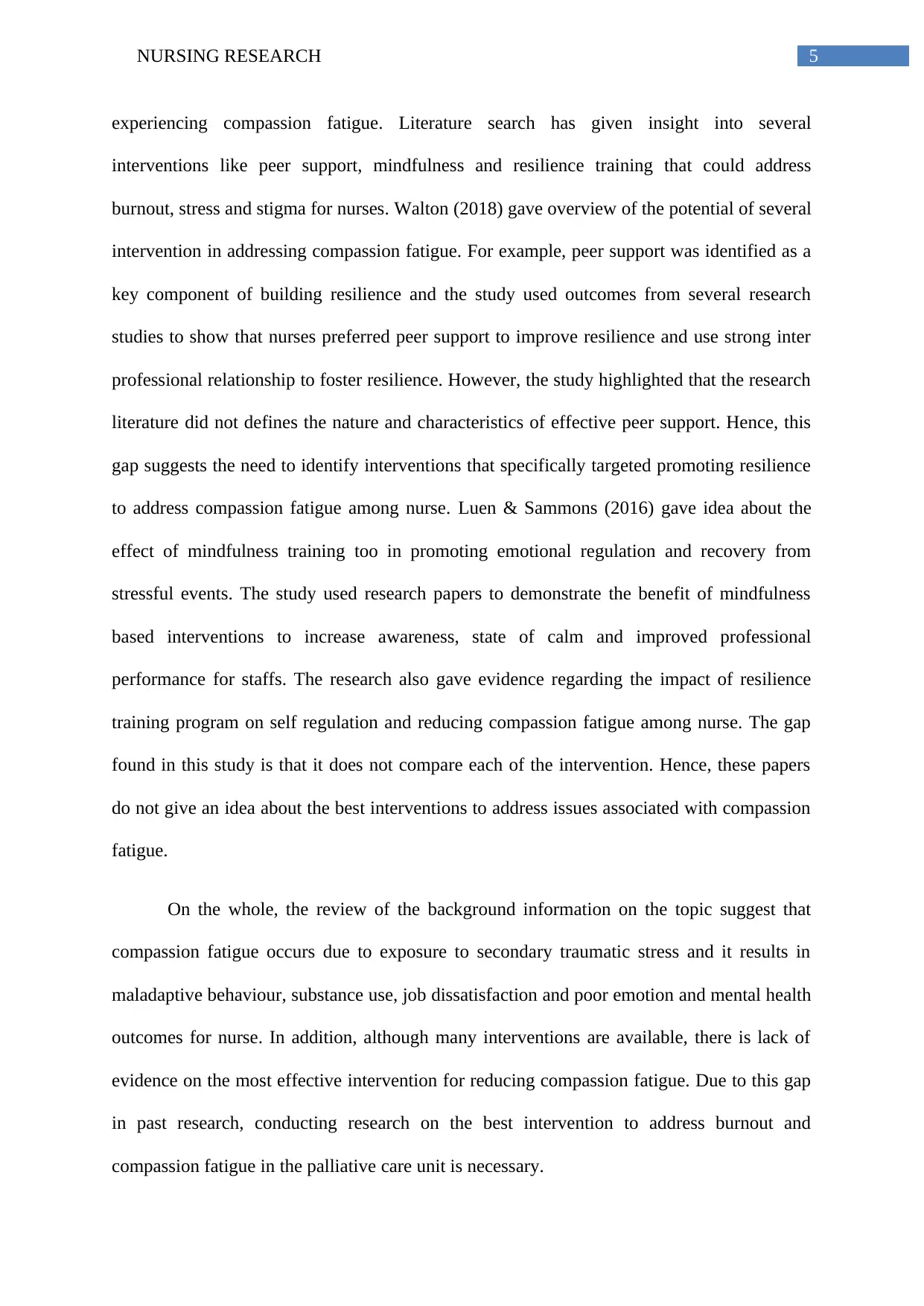
5NURSING RESEARCH
experiencing compassion fatigue. Literature search has given insight into several
interventions like peer support, mindfulness and resilience training that could address
burnout, stress and stigma for nurses. Walton (2018) gave overview of the potential of several
intervention in addressing compassion fatigue. For example, peer support was identified as a
key component of building resilience and the study used outcomes from several research
studies to show that nurses preferred peer support to improve resilience and use strong inter
professional relationship to foster resilience. However, the study highlighted that the research
literature did not defines the nature and characteristics of effective peer support. Hence, this
gap suggests the need to identify interventions that specifically targeted promoting resilience
to address compassion fatigue among nurse. Luen & Sammons (2016) gave idea about the
effect of mindfulness training too in promoting emotional regulation and recovery from
stressful events. The study used research papers to demonstrate the benefit of mindfulness
based interventions to increase awareness, state of calm and improved professional
performance for staffs. The research also gave evidence regarding the impact of resilience
training program on self regulation and reducing compassion fatigue among nurse. The gap
found in this study is that it does not compare each of the intervention. Hence, these papers
do not give an idea about the best interventions to address issues associated with compassion
fatigue.
On the whole, the review of the background information on the topic suggest that
compassion fatigue occurs due to exposure to secondary traumatic stress and it results in
maladaptive behaviour, substance use, job dissatisfaction and poor emotion and mental health
outcomes for nurse. In addition, although many interventions are available, there is lack of
evidence on the most effective intervention for reducing compassion fatigue. Due to this gap
in past research, conducting research on the best intervention to address burnout and
compassion fatigue in the palliative care unit is necessary.
experiencing compassion fatigue. Literature search has given insight into several
interventions like peer support, mindfulness and resilience training that could address
burnout, stress and stigma for nurses. Walton (2018) gave overview of the potential of several
intervention in addressing compassion fatigue. For example, peer support was identified as a
key component of building resilience and the study used outcomes from several research
studies to show that nurses preferred peer support to improve resilience and use strong inter
professional relationship to foster resilience. However, the study highlighted that the research
literature did not defines the nature and characteristics of effective peer support. Hence, this
gap suggests the need to identify interventions that specifically targeted promoting resilience
to address compassion fatigue among nurse. Luen & Sammons (2016) gave idea about the
effect of mindfulness training too in promoting emotional regulation and recovery from
stressful events. The study used research papers to demonstrate the benefit of mindfulness
based interventions to increase awareness, state of calm and improved professional
performance for staffs. The research also gave evidence regarding the impact of resilience
training program on self regulation and reducing compassion fatigue among nurse. The gap
found in this study is that it does not compare each of the intervention. Hence, these papers
do not give an idea about the best interventions to address issues associated with compassion
fatigue.
On the whole, the review of the background information on the topic suggest that
compassion fatigue occurs due to exposure to secondary traumatic stress and it results in
maladaptive behaviour, substance use, job dissatisfaction and poor emotion and mental health
outcomes for nurse. In addition, although many interventions are available, there is lack of
evidence on the most effective intervention for reducing compassion fatigue. Due to this gap
in past research, conducting research on the best intervention to address burnout and
compassion fatigue in the palliative care unit is necessary.
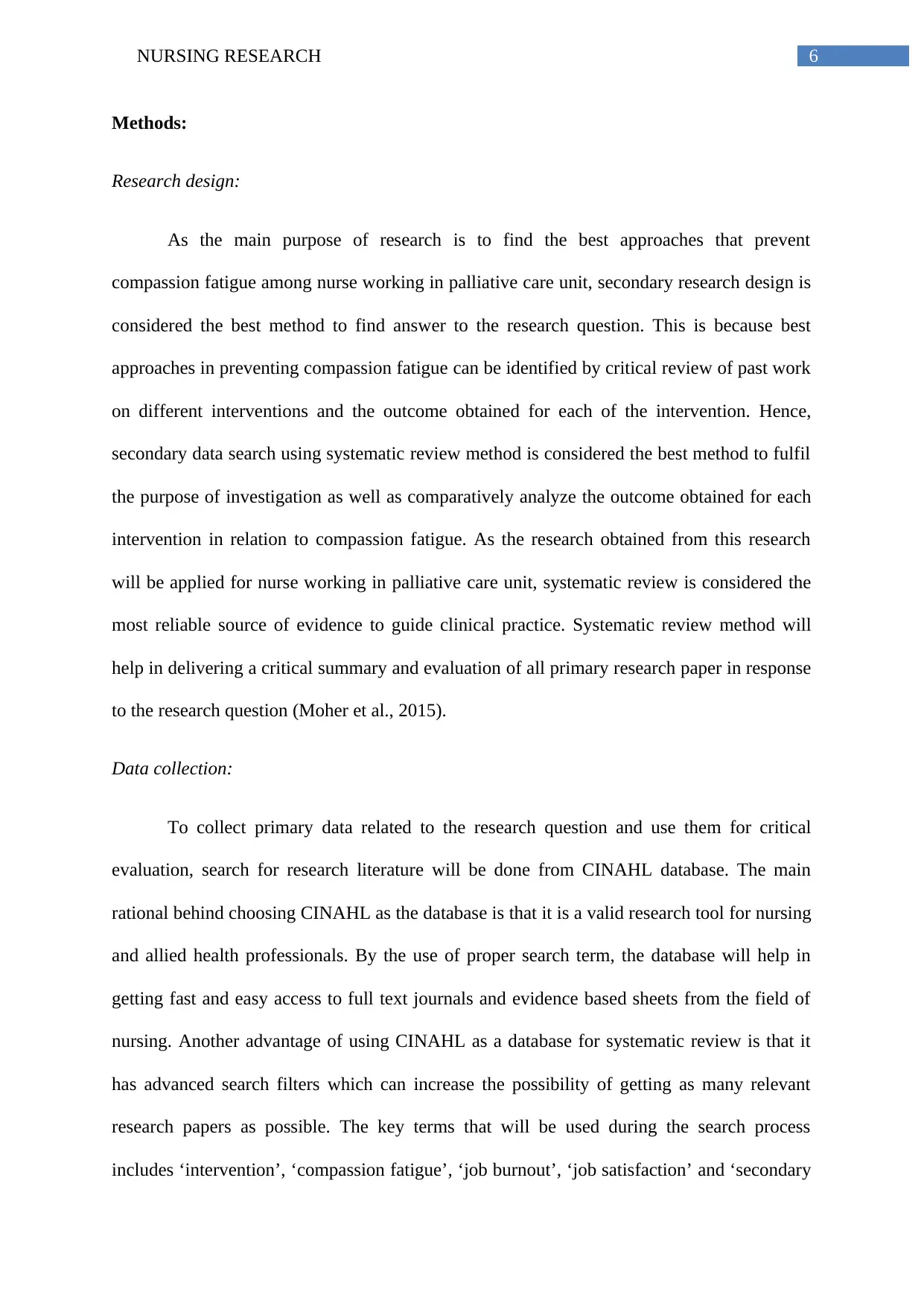
6NURSING RESEARCH
Methods:
Research design:
As the main purpose of research is to find the best approaches that prevent
compassion fatigue among nurse working in palliative care unit, secondary research design is
considered the best method to find answer to the research question. This is because best
approaches in preventing compassion fatigue can be identified by critical review of past work
on different interventions and the outcome obtained for each of the intervention. Hence,
secondary data search using systematic review method is considered the best method to fulfil
the purpose of investigation as well as comparatively analyze the outcome obtained for each
intervention in relation to compassion fatigue. As the research obtained from this research
will be applied for nurse working in palliative care unit, systematic review is considered the
most reliable source of evidence to guide clinical practice. Systematic review method will
help in delivering a critical summary and evaluation of all primary research paper in response
to the research question (Moher et al., 2015).
Data collection:
To collect primary data related to the research question and use them for critical
evaluation, search for research literature will be done from CINAHL database. The main
rational behind choosing CINAHL as the database is that it is a valid research tool for nursing
and allied health professionals. By the use of proper search term, the database will help in
getting fast and easy access to full text journals and evidence based sheets from the field of
nursing. Another advantage of using CINAHL as a database for systematic review is that it
has advanced search filters which can increase the possibility of getting as many relevant
research papers as possible. The key terms that will be used during the search process
includes ‘intervention’, ‘compassion fatigue’, ‘job burnout’, ‘job satisfaction’ and ‘secondary
Methods:
Research design:
As the main purpose of research is to find the best approaches that prevent
compassion fatigue among nurse working in palliative care unit, secondary research design is
considered the best method to find answer to the research question. This is because best
approaches in preventing compassion fatigue can be identified by critical review of past work
on different interventions and the outcome obtained for each of the intervention. Hence,
secondary data search using systematic review method is considered the best method to fulfil
the purpose of investigation as well as comparatively analyze the outcome obtained for each
intervention in relation to compassion fatigue. As the research obtained from this research
will be applied for nurse working in palliative care unit, systematic review is considered the
most reliable source of evidence to guide clinical practice. Systematic review method will
help in delivering a critical summary and evaluation of all primary research paper in response
to the research question (Moher et al., 2015).
Data collection:
To collect primary data related to the research question and use them for critical
evaluation, search for research literature will be done from CINAHL database. The main
rational behind choosing CINAHL as the database is that it is a valid research tool for nursing
and allied health professionals. By the use of proper search term, the database will help in
getting fast and easy access to full text journals and evidence based sheets from the field of
nursing. Another advantage of using CINAHL as a database for systematic review is that it
has advanced search filters which can increase the possibility of getting as many relevant
research papers as possible. The key terms that will be used during the search process
includes ‘intervention’, ‘compassion fatigue’, ‘job burnout’, ‘job satisfaction’ and ‘secondary
Paraphrase This Document
Need a fresh take? Get an instant paraphrase of this document with our AI Paraphraser

7NURSING RESEARCH
traumatic stress’. Along with the use of these search terms, another strategy will be to use
Boolean operators like ‘AND’ and ‘OR’ to ensure that research papers with relevant search
terms are found in single research paper. This step will enhance the relevance of the search
process. The methods by which the key terms will be combined with Boolean operators are as
follows:
Intervention AND Compassion fatigue
Intervention AND job burnout
Strategy AND secondary traumatic stress
By the use of above approach, several key terms will be combined to find papers that
discusses about the interventions implemented to reduce compassion fatigue and burnout.
Certain inclusion and exclusion criteria also guide the search processes which are as follows:
Population: The sample population for each study must be nurses particularly working in
palliative care unit
Intervention: All studies must report about interventions to address secondary traumatic
stress and compassion fatigue. The intervention should be linked to education, self efficacy,
resilience and self regulatory skills.
Study design: Only those papers will be selected which has primary research designs and
secondary research papers will be excluded from the review.
Publication: All the articles must be published in peer reviewed journal and they should be
published within 2009. Research papers published before 2009 will be excluded.
Language: Only those research papers will be included which are published in English
language.
traumatic stress’. Along with the use of these search terms, another strategy will be to use
Boolean operators like ‘AND’ and ‘OR’ to ensure that research papers with relevant search
terms are found in single research paper. This step will enhance the relevance of the search
process. The methods by which the key terms will be combined with Boolean operators are as
follows:
Intervention AND Compassion fatigue
Intervention AND job burnout
Strategy AND secondary traumatic stress
By the use of above approach, several key terms will be combined to find papers that
discusses about the interventions implemented to reduce compassion fatigue and burnout.
Certain inclusion and exclusion criteria also guide the search processes which are as follows:
Population: The sample population for each study must be nurses particularly working in
palliative care unit
Intervention: All studies must report about interventions to address secondary traumatic
stress and compassion fatigue. The intervention should be linked to education, self efficacy,
resilience and self regulatory skills.
Study design: Only those papers will be selected which has primary research designs and
secondary research papers will be excluded from the review.
Publication: All the articles must be published in peer reviewed journal and they should be
published within 2009. Research papers published before 2009 will be excluded.
Language: Only those research papers will be included which are published in English
language.
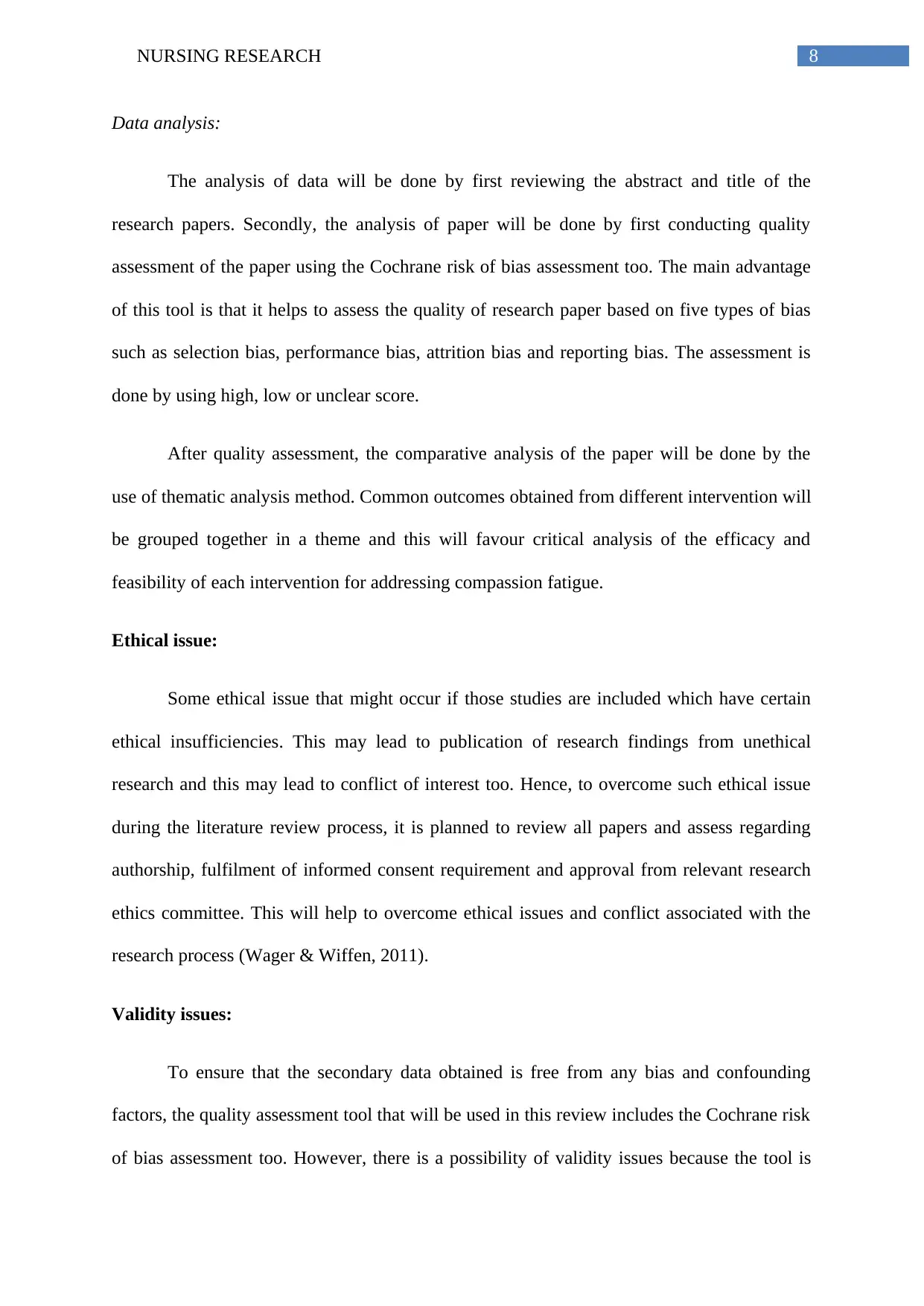
8NURSING RESEARCH
Data analysis:
The analysis of data will be done by first reviewing the abstract and title of the
research papers. Secondly, the analysis of paper will be done by first conducting quality
assessment of the paper using the Cochrane risk of bias assessment too. The main advantage
of this tool is that it helps to assess the quality of research paper based on five types of bias
such as selection bias, performance bias, attrition bias and reporting bias. The assessment is
done by using high, low or unclear score.
After quality assessment, the comparative analysis of the paper will be done by the
use of thematic analysis method. Common outcomes obtained from different intervention will
be grouped together in a theme and this will favour critical analysis of the efficacy and
feasibility of each intervention for addressing compassion fatigue.
Ethical issue:
Some ethical issue that might occur if those studies are included which have certain
ethical insufficiencies. This may lead to publication of research findings from unethical
research and this may lead to conflict of interest too. Hence, to overcome such ethical issue
during the literature review process, it is planned to review all papers and assess regarding
authorship, fulfilment of informed consent requirement and approval from relevant research
ethics committee. This will help to overcome ethical issues and conflict associated with the
research process (Wager & Wiffen, 2011).
Validity issues:
To ensure that the secondary data obtained is free from any bias and confounding
factors, the quality assessment tool that will be used in this review includes the Cochrane risk
of bias assessment too. However, there is a possibility of validity issues because the tool is
Data analysis:
The analysis of data will be done by first reviewing the abstract and title of the
research papers. Secondly, the analysis of paper will be done by first conducting quality
assessment of the paper using the Cochrane risk of bias assessment too. The main advantage
of this tool is that it helps to assess the quality of research paper based on five types of bias
such as selection bias, performance bias, attrition bias and reporting bias. The assessment is
done by using high, low or unclear score.
After quality assessment, the comparative analysis of the paper will be done by the
use of thematic analysis method. Common outcomes obtained from different intervention will
be grouped together in a theme and this will favour critical analysis of the efficacy and
feasibility of each intervention for addressing compassion fatigue.
Ethical issue:
Some ethical issue that might occur if those studies are included which have certain
ethical insufficiencies. This may lead to publication of research findings from unethical
research and this may lead to conflict of interest too. Hence, to overcome such ethical issue
during the literature review process, it is planned to review all papers and assess regarding
authorship, fulfilment of informed consent requirement and approval from relevant research
ethics committee. This will help to overcome ethical issues and conflict associated with the
research process (Wager & Wiffen, 2011).
Validity issues:
To ensure that the secondary data obtained is free from any bias and confounding
factors, the quality assessment tool that will be used in this review includes the Cochrane risk
of bias assessment too. However, there is a possibility of validity issues because the tool is
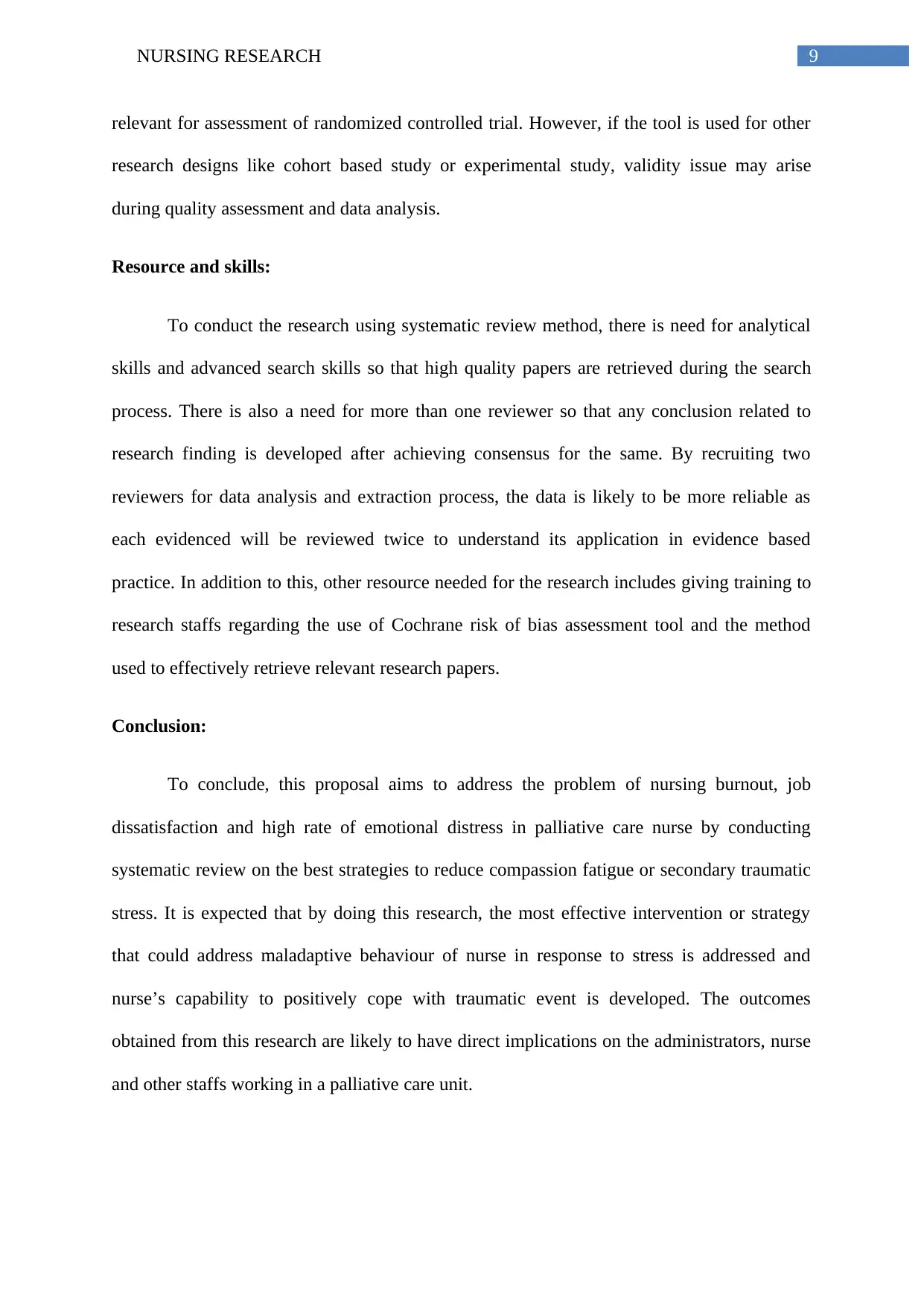
9NURSING RESEARCH
relevant for assessment of randomized controlled trial. However, if the tool is used for other
research designs like cohort based study or experimental study, validity issue may arise
during quality assessment and data analysis.
Resource and skills:
To conduct the research using systematic review method, there is need for analytical
skills and advanced search skills so that high quality papers are retrieved during the search
process. There is also a need for more than one reviewer so that any conclusion related to
research finding is developed after achieving consensus for the same. By recruiting two
reviewers for data analysis and extraction process, the data is likely to be more reliable as
each evidenced will be reviewed twice to understand its application in evidence based
practice. In addition to this, other resource needed for the research includes giving training to
research staffs regarding the use of Cochrane risk of bias assessment tool and the method
used to effectively retrieve relevant research papers.
Conclusion:
To conclude, this proposal aims to address the problem of nursing burnout, job
dissatisfaction and high rate of emotional distress in palliative care nurse by conducting
systematic review on the best strategies to reduce compassion fatigue or secondary traumatic
stress. It is expected that by doing this research, the most effective intervention or strategy
that could address maladaptive behaviour of nurse in response to stress is addressed and
nurse’s capability to positively cope with traumatic event is developed. The outcomes
obtained from this research are likely to have direct implications on the administrators, nurse
and other staffs working in a palliative care unit.
relevant for assessment of randomized controlled trial. However, if the tool is used for other
research designs like cohort based study or experimental study, validity issue may arise
during quality assessment and data analysis.
Resource and skills:
To conduct the research using systematic review method, there is need for analytical
skills and advanced search skills so that high quality papers are retrieved during the search
process. There is also a need for more than one reviewer so that any conclusion related to
research finding is developed after achieving consensus for the same. By recruiting two
reviewers for data analysis and extraction process, the data is likely to be more reliable as
each evidenced will be reviewed twice to understand its application in evidence based
practice. In addition to this, other resource needed for the research includes giving training to
research staffs regarding the use of Cochrane risk of bias assessment tool and the method
used to effectively retrieve relevant research papers.
Conclusion:
To conclude, this proposal aims to address the problem of nursing burnout, job
dissatisfaction and high rate of emotional distress in palliative care nurse by conducting
systematic review on the best strategies to reduce compassion fatigue or secondary traumatic
stress. It is expected that by doing this research, the most effective intervention or strategy
that could address maladaptive behaviour of nurse in response to stress is addressed and
nurse’s capability to positively cope with traumatic event is developed. The outcomes
obtained from this research are likely to have direct implications on the administrators, nurse
and other staffs working in a palliative care unit.
Secure Best Marks with AI Grader
Need help grading? Try our AI Grader for instant feedback on your assignments.
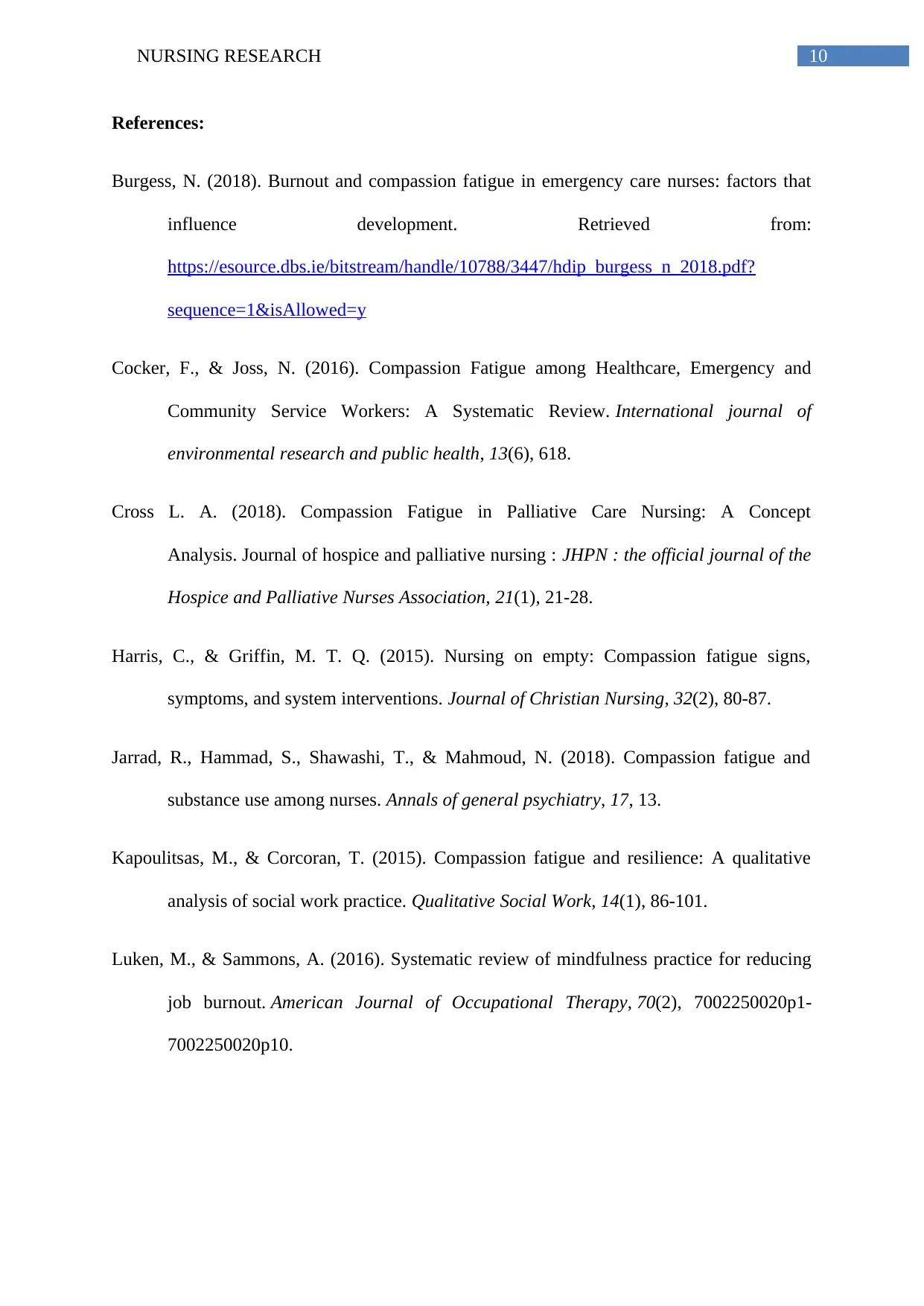
10NURSING RESEARCH
References:
Burgess, N. (2018). Burnout and compassion fatigue in emergency care nurses: factors that
influence development. Retrieved from:
https://esource.dbs.ie/bitstream/handle/10788/3447/hdip_burgess_n_2018.pdf?
sequence=1&isAllowed=y
Cocker, F., & Joss, N. (2016). Compassion Fatigue among Healthcare, Emergency and
Community Service Workers: A Systematic Review. International journal of
environmental research and public health, 13(6), 618.
Cross L. A. (2018). Compassion Fatigue in Palliative Care Nursing: A Concept
Analysis. Journal of hospice and palliative nursing : JHPN : the official journal of the
Hospice and Palliative Nurses Association, 21(1), 21-28.
Harris, C., & Griffin, M. T. Q. (2015). Nursing on empty: Compassion fatigue signs,
symptoms, and system interventions. Journal of Christian Nursing, 32(2), 80-87.
Jarrad, R., Hammad, S., Shawashi, T., & Mahmoud, N. (2018). Compassion fatigue and
substance use among nurses. Annals of general psychiatry, 17, 13.
Kapoulitsas, M., & Corcoran, T. (2015). Compassion fatigue and resilience: A qualitative
analysis of social work practice. Qualitative Social Work, 14(1), 86-101.
Luken, M., & Sammons, A. (2016). Systematic review of mindfulness practice for reducing
job burnout. American Journal of Occupational Therapy, 70(2), 7002250020p1-
7002250020p10.
References:
Burgess, N. (2018). Burnout and compassion fatigue in emergency care nurses: factors that
influence development. Retrieved from:
https://esource.dbs.ie/bitstream/handle/10788/3447/hdip_burgess_n_2018.pdf?
sequence=1&isAllowed=y
Cocker, F., & Joss, N. (2016). Compassion Fatigue among Healthcare, Emergency and
Community Service Workers: A Systematic Review. International journal of
environmental research and public health, 13(6), 618.
Cross L. A. (2018). Compassion Fatigue in Palliative Care Nursing: A Concept
Analysis. Journal of hospice and palliative nursing : JHPN : the official journal of the
Hospice and Palliative Nurses Association, 21(1), 21-28.
Harris, C., & Griffin, M. T. Q. (2015). Nursing on empty: Compassion fatigue signs,
symptoms, and system interventions. Journal of Christian Nursing, 32(2), 80-87.
Jarrad, R., Hammad, S., Shawashi, T., & Mahmoud, N. (2018). Compassion fatigue and
substance use among nurses. Annals of general psychiatry, 17, 13.
Kapoulitsas, M., & Corcoran, T. (2015). Compassion fatigue and resilience: A qualitative
analysis of social work practice. Qualitative Social Work, 14(1), 86-101.
Luken, M., & Sammons, A. (2016). Systematic review of mindfulness practice for reducing
job burnout. American Journal of Occupational Therapy, 70(2), 7002250020p1-
7002250020p10.
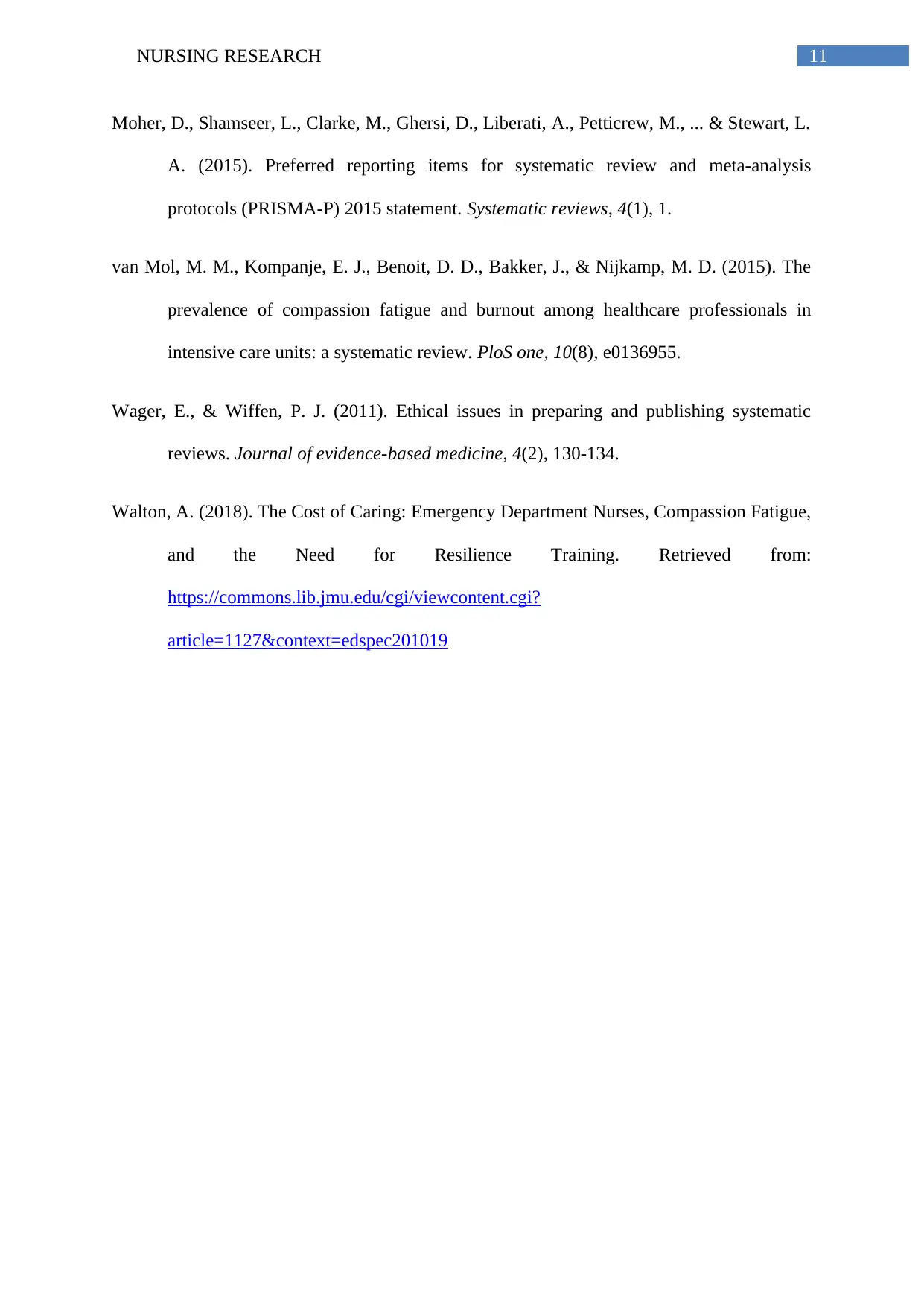
11NURSING RESEARCH
Moher, D., Shamseer, L., Clarke, M., Ghersi, D., Liberati, A., Petticrew, M., ... & Stewart, L.
A. (2015). Preferred reporting items for systematic review and meta-analysis
protocols (PRISMA-P) 2015 statement. Systematic reviews, 4(1), 1.
van Mol, M. M., Kompanje, E. J., Benoit, D. D., Bakker, J., & Nijkamp, M. D. (2015). The
prevalence of compassion fatigue and burnout among healthcare professionals in
intensive care units: a systematic review. PloS one, 10(8), e0136955.
Wager, E., & Wiffen, P. J. (2011). Ethical issues in preparing and publishing systematic
reviews. Journal of evidence-based medicine, 4(2), 130-134.
Walton, A. (2018). The Cost of Caring: Emergency Department Nurses, Compassion Fatigue,
and the Need for Resilience Training. Retrieved from:
https://commons.lib.jmu.edu/cgi/viewcontent.cgi?
article=1127&context=edspec201019
Moher, D., Shamseer, L., Clarke, M., Ghersi, D., Liberati, A., Petticrew, M., ... & Stewart, L.
A. (2015). Preferred reporting items for systematic review and meta-analysis
protocols (PRISMA-P) 2015 statement. Systematic reviews, 4(1), 1.
van Mol, M. M., Kompanje, E. J., Benoit, D. D., Bakker, J., & Nijkamp, M. D. (2015). The
prevalence of compassion fatigue and burnout among healthcare professionals in
intensive care units: a systematic review. PloS one, 10(8), e0136955.
Wager, E., & Wiffen, P. J. (2011). Ethical issues in preparing and publishing systematic
reviews. Journal of evidence-based medicine, 4(2), 130-134.
Walton, A. (2018). The Cost of Caring: Emergency Department Nurses, Compassion Fatigue,
and the Need for Resilience Training. Retrieved from:
https://commons.lib.jmu.edu/cgi/viewcontent.cgi?
article=1127&context=edspec201019
1 out of 12
Related Documents
Your All-in-One AI-Powered Toolkit for Academic Success.
+13062052269
info@desklib.com
Available 24*7 on WhatsApp / Email
![[object Object]](/_next/static/media/star-bottom.7253800d.svg)
Unlock your academic potential
© 2024 | Zucol Services PVT LTD | All rights reserved.





